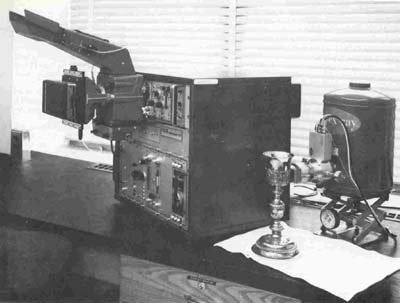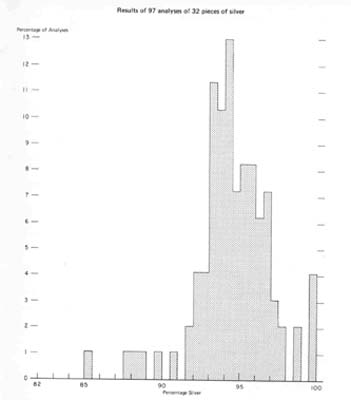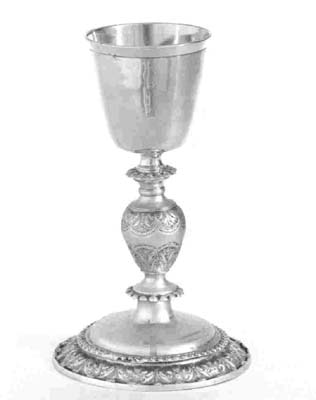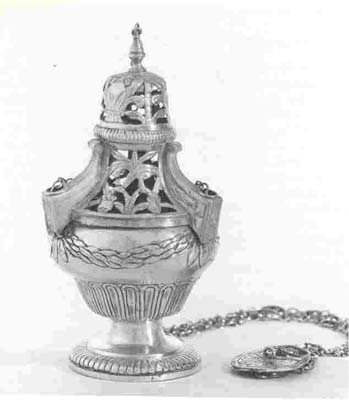
Bulletin 21, 1973
Home
Français
Introduction
History
Annual Index
Author &
Subject
Credits
Contact





The
Compositional Analysis of
French-Canadian Church Silver
by R. M. Myers and J. F. Hanlan
Canadian Conservation Institute*
Résumé en français
Pages 1 | 2 |
3 | 4
Introduction
*The authors would like to express their appreciation for the
advice, co-operation, and guidance of Jean Trudel, and for the
interest and encouragement shown by Dr Nathan Stolow throughout this
work.
The traditional study of cultural artifacts by means of historical
research and connoisseurship is becoming increasingly complemented
by scientific examination and analysis. Frequently the
historian or curator may have new lines of research suggested to him
by such scientific studies or have subjective appreciations
validated. Often technical data will necessitate re-evaluation of an
object.
In conjunction with research into materials for an important
exhibition of French-Canadian and French silver - Silver in New
Francet - held at the National Gallery in 1974, the chemical
analysis of Church silver currently in the National Gallery
collection was undertaken. It was felt that the establishment of
composition would provide important information on aspects of silver
and silversmithing concerning work - shop practices, availability of
raw material, and possible compliance with French guild rules in
early Canada. The emergence of correlations between composition and
silversmith (or period) was also a possible result, as was the
discovery of repairs, additions. or mismatches. Comparison of our
results with those from a similar study of early American silver
currently underway at the laboratory of the Henry Francis du Pont
Winterthur Museum in Winterthur, Delaware (1) can be expected to be
illuminating.
Church silver has certain unique advantages for a study of this
type, because in general the silversmith used the best grade of
silver available - and the pieces are in good condition, positively
identified, and well-polished. The National Gallery's particular
collection was also convenient in that the main artists represented
- François Ranvoyzé, Laurent Amiot, and François Sasseville - did most of their work from the years 1760 to 1864, in three
different periods, including one of the most prosperous eras of
silversmithing in Canada.
One major problem with a study of this type is the fact that no
original Canadian silver was used because there were no mines
discovered, and thus all articles were produced from remelted silver
objects, coins, and scrap. Out of the melting-pot came a whole range
of alloys; no worker can therefore be expected to exhibit any
consistent fineness of metal, or even the constant use of metal from
one particular source.
Experimental
All analyses were done using X-ray fluorescence spectroscopy with an
energy dispersive detector (EDX) (fig. I). Because of the great
efficiency of this type of detector, compact and safe radioisotope
excitation can be used, and analyses are performed very rapidly.
The main advantage, however, for museum applications is that simple
elemental analyses can be done on select areas of a precious or
fragile object without the need for removal of samples. (For a further discussion of this technique, see Appendix, and notes 2,
3, 4
and 5.)
A calibration curve was prepared by positioning a series of copper
(Cu) and silver (Ag) standards (% Cu / % Ag - 50 / 50, 20 / 80, 10 /
90) in
front of the detector and counting the Cu Kx and Ag Kx
characteristic X-rays and two background channels around the copper
peak, which were subtracted. Background in the vicinity of the
silver peak is insignificant and was ignored. The corrected copper
to silver counts ratio was then calculated and plotted as a function
of % Cu / % Ag on log-log paper according to a method used by Bertin, (6)
resulting in a straight line plot. By using a ratio method, the
effects of instrument instability, radioactive source decay, and
distance or orientation from sample to detector are minimized, and
constant recalibration is unnecessary. The log-log plot was also
necessary to ensure that extrapolation of the curve to the 90-100%
Ag region could be done with confidence. To check the curve during
the study a silver blank of approximately 80% Ag was polished
until both sides gave the same copper/silver counts ratio, and then
three pieces cut from it underwent wet analysis, giving 79.0% Ag.
Over a two-month period, with readings on twenty-three different
days, the EDX gave an average reading of 79.0 + / -.5% Ag at the 95% confidence level for the remaining portion of the blank.
A silver object was analyzed by positioning it so that the area of
interest was about one-eighth of an inch in front of the
excitation Source, and the total spectrum count rate was then
adjusted to about 2,000 counts per second using the collimator. Two
readings for each area were taken in order to improve the statistical accuracy. From this, the
copper / silver ratios were calculated
and the percentage silver was read from the calibration graph.
Finally the two percentages were averaged.
Because any X-ray fluorescence method only analyzes the surface
(e.g., the Cu Kx fluorescent X-rays originate from a maximum depth
of .03 mm in a 95% Ag sample), it is most important that the
surface be representative of the composition of the object as a
whole. This is not always the case, because in almost all alloys the
effect of surface enrichment, or more correctly, surface depletion,
of one or more components changes the surface composition with
respect to the interior. The effect can be caused by oxidation, or
by leaching out of a component, or simply by diffusion of one
component through the matrix. The enrichment is not always apparent,
because in general no pitting, corrosion, or any other visible
change takes place. Objects fabricated from silver were also
typically whitened by a process known as blanching, which leaves a
silver-rich layer on the surface. It is important then that these
effects do not cause misleadingly high results for the silver
percentage. In a study by Carter (7) in which the enriched surface
layer on silver coins was removed by blasting with aluminum oxide
powder, it was found that usually about one-thousandth of an inch
(0.0254 mm) of the surface had to be removed to get an accurate
X-ray fluorescence reading. Removal of just 0.014 mm of surface
metal from a silver coffee-pot analyzed by EDX by Hanson resulted
in a jump from 2.2% to 5.8% Cu. It was thus decided that
with fairly constant polishing on a smooth surface, no enriched
layer would exist.
Next Page | Results
1 | 2 | 3 |
4
Annual Index | Author & Subject | Credits | Contact
This digital collection
was produced under contract to Canada's Digital Collections program,
Industry Canada.
"Digital
Collections Program, Copyright
© National Gallery of
Canada 2001"